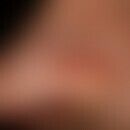Synonym(s)
HistoryThis section has been translated automatically.
DefinitionThis section has been translated automatically.
Special form of pemphigus disease with herpetiform, very itchy or burning, papulovesicular, anular or circinate skin manifestations on an erythematous base, usually in clinically manifest pemphigus foliaceus (variant of pemphigus foliaceus?), rarely in pemphigus vulgaris.
You might also be interested in
Occurrence/EpidemiologyThis section has been translated automatically.
ManifestationThis section has been translated automatically.
ClinicThis section has been translated automatically.
HistologyThis section has been translated automatically.
Superficial blistering: eosinophilic spongiosis. Intraepidermal and subcorneal microabscesses with neutrophils and eosinophils. Acantholysis may be absent!
Direct ImmunofluorescenceThis section has been translated automatically.
IgG, e.g. against desmoglein 1 (Dsg-1) and desmocollin 3 (Dsg-3) in the intercellular space of the epidermis. Antibodies against desmocollins are rarer.
DiagnosisThis section has been translated automatically.
Differential diagnosisThis section has been translated automatically.
TherapyThis section has been translated automatically.
See pemphigus vulgaris below. Systemic glucocorticoids such as prednisolone (e.g. Decortin H) initially 60-90 mg/day, then reduction to maintenance dose.
Alternatively: DADPS (e.g. dapsone-fatol) 50-150 mg/day p.o. Good response is reported in the literature (Kühn J et al. (2023).
Progression/forecastThis section has been translated automatically.
LiteratureThis section has been translated automatically.
- Ahmed AR, Sami N (2002) Intravenous immunoglobulin therapy for patients with pemphigus foliaceus unresponsive to conventional therapy. J Am Acad Dermatol 46: 42-49
- Enk AH, Knop J (1998) Adjuvant therapy of pemphigus vulgaris and pemphigus foliaceus with intravenous immunoglobulins. Dermatologist 49: 774-776
- Floden C, Gentale H (1955) A case of clinically typical dermatitis herpetiformis (M. Duhring) presenting acantholylysis. Acta Derm Venereol (Stockh) 35: 128
- Goebeler M et al (2003) Blistering autoimmune diseases of childhood. Dermatologist 54: 14-24
- Kozlowska A et al. (2003) Pemphigus herpetiformis with IgA and IgG antibodies to desmoglein 1 and IgG antibodies to desmocollin 3. J Am Acad Dermatol 48: 117-122
- Kühn J et al. (2023) Transformation of pemphigus foliaceus into pemphigus herpetiformis. J Dtsch Dermatol Ges 21:655-658.
- Luther H, Kastner U, Altmeyer P (1999) Comment on the contribution by Alexander H. Enk and Jurgen Knop. Adjuvant therapy of pemphigus vulgaris and pemphigus foliaceus with intravenous immunoglobulins Hautarzt 50: 372-374
- Marinovic B et al. (2003) Coexistence of pemphigus herpetiformis and systemic lupus erythematosus. J Eur Acad Dermatol Venereol 17: 316-319
- Robinson ND (1999) The new pemphigus variants. J Am Acad Dermatol 40 (5 Pt 1): 649-671
Incoming links (3)
Autoimmune dermatoses, bullous; Dermatitis herpetiformis, acantholytic; Pemphigus drug-induced;Outgoing links (6)
Dadps; Dermatitis herpetiformis; Glucocorticosteroids; Pemphigus foliaceus; Pemphigus vulgaris; Prednisolone;Disclaimer
Please ask your physician for a reliable diagnosis. This website is only meant as a reference.




